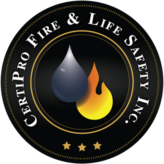According to the most recent report from the National Fire Protection Association (NFPA) on Structure Fires in Eating and Drinking Establishments, between 2010-2014, more than 7,400 fires occurred in restaurants and bars each year. And, every year, these fires, on average, claimed three lives, injured more than 100 people, and caused $165 million in property damage. Of the fires studied by the NFPA, more than 59 percent started in the kitchen – a fact that underscores how important understanding and implementing best practices for fire safety really is.
This article will highlight the legal expectations of restaurant fire safety compliance, as well as best safety practices.
NFPA Required Sequence of Use of Fire Equipment in Restaurants
The NFPA requires that the cooking areas of restaurants and cafeterias have both an automatic fire extinguishing system and portable fire extinguishers. When restaurants are in full compliance with this national consensus standard, they have the best chance of a positive outcome when a fire breaks out, when compared to almost any other property, However, the extinguishing strategy for these buildings must be sequenced differently than most other properties. Unlike most situations where the extinguisher is used as a first line of defense, Class K extinguishers should not be used on a protected appliance fire until after its fire suppression system has been discharged, either automatically or manually. A placard is required to be installed in a conspicuous location and near each Class K extinguisher that states the fire protection system is to be activated prior to using the fire extinguisher [ 96: 10.2.2.}.
Shutting Off Heat Sources
The suppression system installed in most restaurants for the protection of cooking appliances is pre-engineered wet chemical system. There might also be a fire sprinkler system for the protection of the entire building, but the wet chemical system is specifically designed and installed for the cooking area ( including appliances, hoods, and ducts). When that kitchen system operates, there is an interlock that automatically shuts off the heat sources ( both gas and electrical) to the cooking appliances. That is critical to help cooking oil in fryers, griddles, and cooktop stoves cool below its re-ignition temperature.
How the Fire Extinguishing Agent Works
The wet chemical extinguishing agent that is used in the kitchen systems is discharged as a fine mist spray. When it lands on the surface of a cooking oil fire, it chemically reacts with the fats in the oil surface and excludes oxygen in the air from contacting the oil vapors. it effectively suffocates the fire and prevents re-ignition, as long as a the foam remains undisturbed on the surface of the oil.
Employee Instructions
Employees of restaurants are required to be provided with instructions on the use of portable fire extinguishers and how to manually operate the fire extinguishing system. the instructions are to be provided upon original hiring and at least annually thereafter [ 96:11.1.4].
Included in the instructions to the employees should be the following:
- Operation of a pull station (manual actuation) will cause the extinguishing agent to discharge onto the appliances to extinguish the fire. this action automatically shuts off the heat sources to the appliances and helps reduce the chance of re-ignition.
- Whenever an appliance fire occurs, the address of the restaurant, and the name of the manager on duty that can assist with providing information at the fire scene.
Contact us today and request a free estimate to have one of our certified technicians for all of your fire alarm system service needs.
